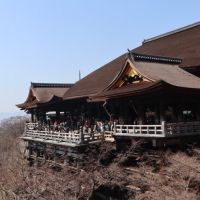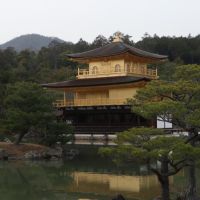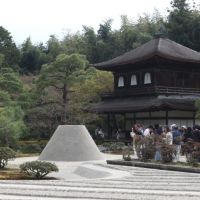Sanjusangendo (Sanjusangen-do) : A Temple Characterized by the Overwhelming Presence of Over a Thousand Buddha Statues
S-fleage
S-fleage is a Kyoto-based company. We are proud to introduce the charms of Kyoto to the world. We hope this article will help you to experience Kyoto.
Latest posts by S-fleage (see all)
- Fushimi Inari Taisha: Enchanting Gates to Eternity – History and Travel Guide - 2024/04/29
- Sanjusangendo (Sanjusangen-do) : A Temple Characterized by the Overwhelming Presence of Over a Thousand Buddha Statues - 2024/04/29
- Ninenzaka: Walking along the most emotional stone-paved slope in Kyoto - 2024/04/22
Sanjusangendo, officially known as Rengeo-in, is a Buddhist temple of the Tendai sect located in the Higashiyama Ward of Kyoto.
The name “Sanjusangendo” translates to “Hall with thirty-three spaces between columns,” describing the architecture of the long main hall of the temple.
Inside the hall, you’ll find 1001 statues of the Thousand-Armed Kannon, along with 28 guardian deities and statues of wind and thunder gods.
These Buddhist sculptures, along with others within the temple, are national treasures for their cultural significance.
The temple complex includes a beautiful garden and two ponds, making it a peaceful and spiritual destination for visitors.
Moreover, Sanjusangendo is renowned for its traditional events. Let’s delve into the allure of Sanjusangendo.

Contents
A Brief History of Sanjusangendo

A corridor characterized by vivid vermilion hues.
Sanjusangendo, constructed in 1165 as an imperial villa by retired Emperor Go-Shirakawa, was part of the Hojuji Palace and financed by Taira no Kiyomori.
Unfortunately, it fell victim to a devastating fire in 1249. However, it was rebuilt in 1266 by retired Emperor Go-Saga, reclaiming its beautiful form.
During the Muromachi period, extensive renovations were undertaken under the shogunate of Ashikaga Yoshimitsu, and further repairs were made during the eras of Toyotomi Hideyoshi and his son Hideyori.
These efforts ensured that Sanjusangen-do retained its splendor.
More recently, in 2017, a meticulous 45-year restoration of all 1,001 statues of the Thousand-Armed Kannon was completed, further enhancing its grandeur.
Through centuries of history, Sanjusangen-do stands as a testament to Japan’s rich cultural and historical legacy.
How to Get to Sanjusangendo

Let me show you how to get to Sanjusangendo from JR Kyoto Station, the center of sightseeing in Kyoto.
From Kyoto Station, take city bus No. 100, 206, or 208 for about 10 minutes and get off at “Hakubutsukan Sanjusangendo-mae”. From there, it is about a one-minute walk. The fare is 230 yen.
Or, since it is close to Kyoto Station, a cab will not cost much. It takes about 10 minutes and costs about 1,000 yen.
Hours and Entrance Fees

Please refer to the following table for the admission fee and visiting hours of Sanjusangendo. Note that visiting hours vary depending on the season.
– April 1st to November 15th: 8:30 a.m. to 5:00 p.m.
– November 16th to March 31st: 9:00 a.m. to 4:00 p.m.
Admission Fee: 600 yen for adults.
Highlights of Sanjusangendo
Watch a video of Sanjusangendo
Inside the Sanjusangendo Hall, taking photos is not allowed, so you cannot photograph any of the Buddha statues inside. However, you can take photos of the exterior of the Sanjusangendo.
Also, under certain conditions and with prior permission, photography and videography may be permitted inside. This video is an advertisement for a Japanese TV program about Sanjusangendo, but it offers a glimpse of the beauty of Sanjusangendo, so be sure to check it out.
The Main Hall of Sanjusangendo

The main hall was reconstructed during the Kamakura period (1266).
The main hall, which is a National Treasure of Japan, measures about 120 meters in length, making it one of the longest wooden structures in the world.
Inside the hall, you’ll find a spectacular sight: a collection of 1,001 statues of thousand-Armed Kannon, the goddess of mercy. Each statue is unique and intricately crafted, creating a forest-like atmosphere of divine figures.
Sanjusangendo is not just an architectural marvel, but also a place of significant religious and historical importance.
Japanese Garden of Sanjusangendo

The East Garden Pond and Strolling Garden.
Within the grounds of Sanjusangendo, visitors will discover a beautiful garden that captures the essence of Japanese history and tradition.
This garden is known as the East Garden Pond and Strolling Garden, a tranquil oasis featuring a serene pond and meandering paths that invite leisurely strolls.
Constructed by the garden designer Kan’nosaku Nakane in 1961. This garden underwent maintenance by Kanhiro Nakane and Naonori Nakane, grandchildren of Kan’nosaku Nakane, in 2021.
Spread across approximately 1,000 square meters, this expansive space combines elements of dry landscape gardens with a pond and strolling garden, creating a unique landscape.
The robust stone arrangements, reminiscent of the Kamakura period, convey the strength of nature.

The garden, adorned with beautiful flowers throughout the seasons, showcases cherry blossoms in spring, hydrangeas in summer, autumn leaves in fall, and snowy scenery in winter, offering different views depending on the season you visit.
It’s worth noting that there are wheelchair-accessible pathways, ensuring that everyone can comfortably stroll around and enjoy the garden.
Taikohbei Walls of Sanjusangendo

The eaves flat tile uses the “Taikoh-ghiri” pattern.
Taikohbei Wall is an Important Cultural Property. It is 5.2 meters high, 92 meters long, and made of wood and earth.
It was donated by Toyotomi Hideyoshi (Taikoh), it creates the atmosphere of the Momoyama Period, a period associated with the Toyotomi family.
It should be noted that the eaves tiles of this wall are decorated with a “Taikoh-ghiri” (paulownia) pattern.
This pattern depicts paulownia flowers and leaves and is said to have been used by Toyotomi Hideyoshi. Due to these features, this wall is referred to as a Taikohbei Wall.
The Taikohbei Wall is located within the precincts of Sanjusangendo, and its imposing presence is overwhelming to visitors.
Buddha statues in Sanjusangendo

Seated Statue of Thousand-Armed Kannon
The Thousand-Armed Kannon statue is a remarkable piece of Buddhist art. Here are some key features:
- The statue is the central image in the Hondo (main hall) of Sanjusangendo.
- It stands eleven feet tall and is decorated with gold leaf over a lacquer undercoating.
- The statue’s eyes are made of crystal.
- It is constructed using the yosegi technique, where wood blocks are hollowed out and assembled to create the statue.
- The statue is a representation of Senju Kannon, the Kannon with a thousand arms and eleven heads.
- The statue is surrounded by 1,000 life-sized statues of Kannon, which are also known as the Thousand-Armed Kannon.
While photography inside the main hall is not permitted, the memory of witnessing these Buddha statues in person is truly unforgettable.
1,000 Standing Statues of Thousand-Armed Kannon
Sanjusangendo is home to 1,000 standing statues of Kannon,the Buddhist goddess of compassion.Each statue has 1,000 arms and 11 heads.They are life-sized and arranged in 10 rows on both sides of a large central statue of Kannon.These statues are considered one of the most beautiful pieces of Buddhist art.
28 Statues of Guardian Deities
The 28 guardian deities at Sanjusangendo are a group of statues that accompany the Thousand-Armed Kannon.They are believed to be the attendants of the Kannon and are positioned in front of the thousand-armed Buddha statues.Each statue is carved out of cypress and covered with gold leaf.These attendants originate from ancient Indian deities and are considered protectors of the Buddhist teachings.
Other Useful Information
The Traditional New Year’s Event “Toshiya “

Events with a history of more than 400 years are held annually.
The Toshiya, a traditional Japanese archery competition held in mid-January, marks the first shooting of arrows in the New Year. Around 2,000 archers from all over Japan participate, including young men and women celebrating their coming-of-age ceremony (usually twenty years old).
The event originated in 1606, when a Samurai demonstrated his archery prowess by shooting a hundred arrows in rapid succession the entire 120-meter length of the temple, hitting the target 51 times. This story inspired the annual archery contest.

The Toshiya event is open to the public. However, in 2024, general entry to the Toshiya venue was prohibited. Also, no photography or video recording was allowed. There were no spectator seats provided. For more details, please check the official website of Sanjusangendo.
Links
Unfortunately, the official website of Sanjusangendo does not have an English version. Check it out using a translator.
Tourist spots around Sanjusangendo
The typical duration for visiting Sanjusangendo is around 30 minutes. While you’re in the vicinity of Sanjusangendo, be sure to check out these nearby attractions:
– Kyoto National Museum: Situated opposite Sanjusangendo, this museum boasts striking Meiji-era architecture. It hosts a variety of captivating exhibitions, and even just admiring its entrance and structure is worthwhile.
– Toyokuni Shrine: Adjacent to the Kyoto National Museum, Toyokuni Shrine enshrines Toyotomi Hideyoshi, a prominent figure in Japanese history.
Its main gate, the Karmon, stands prominently adorned in black and gold, designated as a national treasure. Originally relocated from Fushimi Castle, it features intricate carvings reminiscent of the Momoyama period.
Unique to the shrine are votive tablets shaped like gourds, inspired by Hideyoshi’s personal emblem, which delight visitors.
Sanjusangendo: A place to Admire the Beauty of Japanese Buddhist Sculptures

Enjoy a lush green space filled with flowers of the four seasons.
Sanjusangendo is renowned for its collection of 1001 statues of the Thousand-Armed Kannon, each uniquely crafted and intricately detailed.
Visitors can marvel at the divine figures housed within the temple’s long main hall, experiencing a sense of serenity and spirituality.
It’s a must-visit destination for anyone interested in Japanese culture, history, or Buddhism, offering a glimpse into the country’s rich religious heritage.





